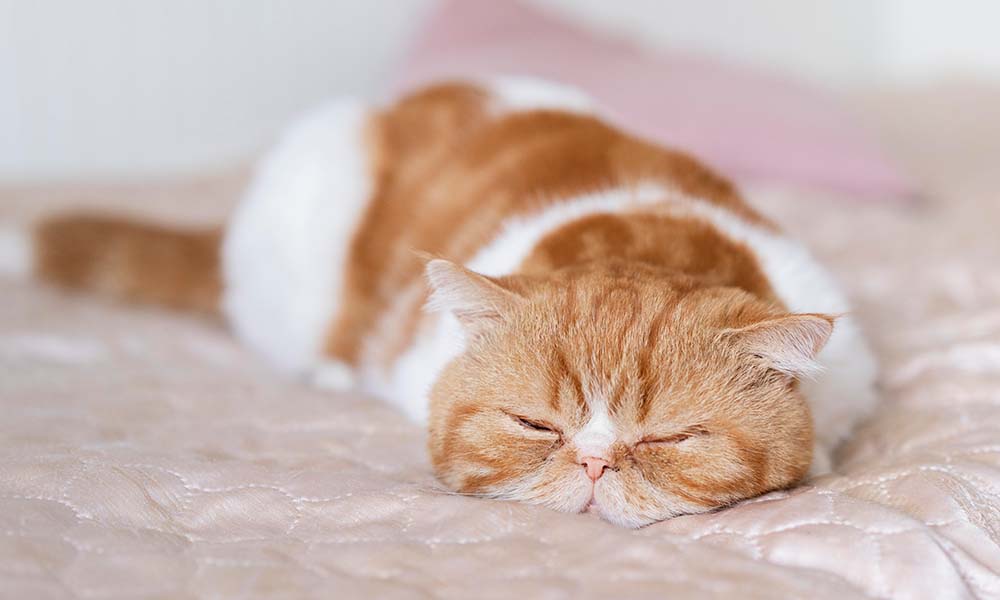Cats are enigmatic creatures, often leaving us to wonder about their secretive lives, especially when it comes to their sleep patterns. The term ‘cat nap’ has seeped into our lexicon, signifying short, restful periods of snooze that cats have mastered, but there’s more to these feline siestas than meets the eye.
Curling up in a sun-soaked corner or stretched out underneath a shade, our feline friends showcase a variety of sleeping habits that can be quite telling. Each purring nap provides insights into their health, happiness, and trust in their environment.
By analysing your kitty’s sleeping habits, one can decode the subtle messages they’re sending. Not only do these slumbering poses and patterns reveal their current state of comfort, but they also offer clues to their instinctual behaviour.
Let’s explore the world of cat naps and unearth what your kitty’s sleeping habits have to disclose.
Unravelling the Mystery of Cat Naps
It is often said that cats live in a perpetual state of readiness, even in slumber. Understanding the cat naps helps us comprehend the intricacies of their restful states, unlocking the secrets they hold about feline nature.
Why Cats Nap: The Biology Behind the Doze
Cats are known for their ability to slip into a state of rest with ease and frequency. This proclivity for napping is deeply ingrained in their biology, originating from their ancestors’ need to conserve energy for hunting. Although domestic cats no longer need to hunt for food, the behaviour persists. A cat nap replenishes their energy, ensuring they’re perpetually poised for action. Thus, their snoozing is not only a matter of rest but an inherited survival tactic.
Moreover, cat sleep cycles are different from humans. Cats experience shorter and more frequent cycles of rapid eye movement (REM) sleep, which is why they can awaken quickly. These frequent cat naps, usually lasting around 15-30 minutes, can occur throughout the day, accounting for their reputation as master snoozers.
Deciphering Patterns: The Frequency and Duration of Cat Naps
Observing the length of your cat’s naps can be quite revealing. Typically, a cat may doze for 12 to 16 hours a day, with kittens and seniors leaning towards the higher end of this spectrum. The frequency and duration of a cat’s naps can reflect its level of activity, age, and even the time of the year. Longer daytime sleeping may result from a night of active prowling or a reaction to the changing seasons.
Moreover, the intervals between naps can also tell you how stimulated your cat is by their environment. A home filled with play and exploration opportunities might lead to shorter cat naps, while a quiet, less stimulating atmosphere could see your cat lounging for longer periods.
Prime Napping Spots: Understanding Your Cat’s Favorite Snooze Locations
The locations where cats choose to nap can signify their comfort and trust in their home. Sun-drenched windowsills, for instance, can be cat nap havens that provide warmth and a view for lazy surveillance. Such preferred spots often have strategic significance – providing a balance of cosiness, safety, and the chance to monitor their territory.
Cats also tend to switch up their sleeping spots, a behaviour rooted in their instinct to stay unpredictable to potential predators and prey. Ensuring multiple napping options, from high perches to secluded corners, caters to their instinctual needs and contributes to their well-being.
The Language of Sleep: Interpreting Your Cat’s Sleeping Positions
Cats communicate volumes through their posture, even when they’re asleep. Learning to interpret these silent signals can deepen your understanding of your cat’s internal state and feelings of security.
The Belly-Up Pose: Trust and Contentment Explored
When a cat sleeps belly-up, it signifies ultimate trust and relaxation. This vulnerable position is typically reserved for safe, secure environments because it exposes their vital organs. If your cat displays this sleeping habit, consider it a compliment; they will feel protected and content with you.
This pose not only indicates trust but can also be a way to cool down, as the belly has fewer fur layers and dissipates heat efficiently. So, cat napping in this fashion on a hot day is instinctually self-soothing, choosing both mental and physical comfort.
The Loaf Position: Security and Observation in Sleep
The “loaf” position, where a cat tucks its paws under its body, resembles a loaf of bread. This position indicates contentment and readiness to spring into action if needed. It’s a cosy yet strategic pose that allows for a quick getaway.
Sleeping in the loaf position can also show that cats keep an ear out for potential dangers. Adopting this pose while resting reveals their instinct to remain alert even while they recharge, demonstrating the fine line they balance between relaxation and vigilance.
The Spy Huddle: Comfort and Warmth in Bundle
The “spy huddle” is a cute and compact sleeping arrangement where cats curl up into a tight ball, often with their face tucked toward their body. This position is a favourite during colder months as it conserves body heat and protects extremities from the chill.
Napping in this manner can also suggest a need for self-soothing, as the compact shape provides a sense of security and comfort. It’s a throwback to kittenhood when they would huddle with their littermates for warmth and emotional bonding.
Cat Nap Chronicles: Age, Health, and Well-Being
The tale that sleep tells changes with age and health in pets. As cats progress through different life stages, their nap patterns can serve as indicators of their general well-being and specific health issues.
Kitten Versus Senior: Sleep Needs Through the Ages
Kittens, much like human infants, require more sleep to support their rapid development. A young cat’s frequent cat naps are vital for their physical growth and cognitive development. As cats age, they naturally tend to sleep more as their metabolism slows, and seniors may enjoy the restorative benefits of sleep more profoundly.
However, a sudden change in the sleeping habits of a cat at any age should prompt attention. Excessive sleep can sometimes be a symptom of underlying health issues such as infection or metabolic disorders, warranting veterinary advice.
Rest as a Healing Mechanism: Sleep and Your Cat’s Health
Sleep serves as a healing time for cats, allowing body tissues to repair and the immune system to rejuvenate. Cats instinctively seek more rest while recovering from illness or injury, showcasing the body’s innate push toward recuperation.
It’s essential to provide a comforting and safe sleep environment during these periods. Observing your cat’s sleep patterns and noting any irregularities can be a step towards early detection of health challenges, ultimately leading to proactive care.
Alertness in Rest: Safety and the Semi-Dozing State
Even while appearing to be in deep slumber, cats are often in a semi-doze state, allowing for immediate alertness. This ability to wake at a moment’s notice is a survival adaptation, ensuring safety and response to potential threats or opportunities.
Cats in a semi-doze are usually positioned in a manner that allows for quick movement, including having their paws positioned under their bodies or the loaf position. Recognising these subtle signs can give insights into your cat’s sense of security within their environment.
Creating a Cat-Friendly Sleep
Creating a cat-friendly atmosphere is crucial in fostering a nurturing and safe environment for our feline companions, integral to their sleep quality and overall happiness.
The Perfect Bed: Features for Feline Comfort
Selecting the perfect cat bed is akin to choosing a sanctuary for your pet. Cats prefer beds that provide warmth, softness, and security. Raised edges, for instance, can simulate the protective embrace of a nest, while heated or self-warming beds can be particularly enticing for older cats suffering from arthritis.
Additionally, the placement of the bed within the home can significantly affect a cat’s willingness to use it. Beds situated in quiet, secure locations are more likely to be used, while those in the busy crossroads of a home may often stand ignored.
The Role of Play and Activity in Better Sleep
An active cat is a well-rested cat. Engaging in regular play sessions with your furry friend is not just about bonding; it’s about ensuring that they expend their energy efficiently, leading to a more structured sleep-wake cycle.
Interactive toys, puzzles, and regular playtimes can help prevent daytime over-napping, which can disrupt nocturnal sleep patterns. Consistent play creates a routine that helps regulate a cat’s body rhythm, making their cat naps more predictable and satisfying.
Stress-Free Spaces: How Environmental Factors Influence Cat Sleep
Just as in humans, stress can profoundly affect a cat’s sleep quality. It is crucial to foster a tranquil home atmosphere for cats to feel relaxed. Minimising loud noises, maintaining a consistent routine, and offering safe hiding spots are ways to reduce anxiety.
Moreover, pheromone diffusers and calming supplements can contribute to a serene ambience, supporting restful sleep. Keeping the living space clean, particularly the areas where cats eat, play, and eliminate, is also vital, as a clean environment supports a peaceful state of mind conducive to blissful cat naps.
At Cat Castle, our stress-free, no-dog boarding ensures a quieter stay, so cats always feel calm and secure.
Conclusion
Understanding the hidden language of your cat’s naps illuminates much about their well-being and personality. From savouring sunlit spots to assuming various sleep postures like the “loaf” or “spy huddle,” each cat nap is a rich tapestry woven from instinct, comfort, and contentment.
By observing these resting rituals, we can ensure our homes cater to their need for safety, play, and tranquillity. Providing a cosy bed in a serene corner, engaging in interactive play, or creating stress-free sanctuaries aids in sweet slumber—for both the cat and owner alike.
Remember, a cat in a blissful state of repose is a snapshot of feline happiness, and every cat nap they take is a small window into their trust and satisfaction with their environment.
For top-notch care, book now with Cat Castle.
Frequently Asked Questions
The average cat nap typically lasts anywhere from 15 minutes to a few hours. However, it’s not unusual for cats to sleep for about 12 to 16 hours throughout the whole day, in smaller increments. Cats have a natural propensity to conserve energy by sleeping, which is why they frequently engage in numerous cat naps.
Yes, excessive cat napping can sometimes be an indicator of health problems. While cats are known for sleeping a lot, a sudden increase in sleep duration or an abnormally high number of cat naps could signal that your pet is experiencing discomfort, illness, or stress. If your cat is sleeping more than usual, it’s a good idea to consult with a veterinarian to rule out any underlying health issues.
When a cat’s nap patterns change abruptly, it can be a sign of several things. Stress, environmental changes, illness, or age-related factors can affect how often your cat engages in cat naps. It could also mean that your cat is adapting to new routines or changes in the household. If you notice any sudden changes that persist, it’s wise to pay a visit to the vet to ensure everything is fine with your feline friend.
To ensure your cat is getting enough rest during their daily nap routine, create a comfortable and quiet sleeping environment. Provide cosy beds or spots that are only for them, keep the noise level down during their nap times, and try to keep a consistent routine so they can establish regular sleep patterns. Additionally, interactive play sessions can help them burn off energy and prepare for a good rest during their cat naps.
Yes, certain cat breeds are prone to longer or shorter cat naps. For example, active breeds like the Abyssinian may nap less frequently or for shorter periods as they tend to be more energetic and playful. Conversely, more sedentary breeds like the Persian may indulge in longer or more frequent cat naps due to their laid-back personalities. It’s important to consider that individual cats also have unique characteristics and may not always fit the typical breed-specific sleep patterns.





